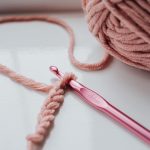Are you struggling with sewing stretchy fabrics by hand? Don’t worry, you’re not alone. Many people find it challenging to sew materials like lycra, spandex, and jersey without using a sewing machine.
However, with the right tools and techniques, you can create beautiful and durable hand-stitched garments.
In this article, you’ll learn about:
- The challenges of sewing stretchy fabrics
- How to choose the right needle and thread
- Basic hand stitches that work well with these materials
- Tips for effective hand stitching
- Reinforcement stitches to strengthen your seams
- Finishing techniques to give your project a professional look
- Troubleshooting common issues that may arise.
So, let’s dive in and master the art of hand stitching for stretchy fabrics!
Table of Contents
Understanding the Challenges of Sewing Stretchy Fabrics
You’re probably thinking that sewing stretchy fabrics is a nightmare, but don’t worry, it’s not as hard as it seems. However, it does come with its own set of challenges.
The main issue with stretchy fabrics is that they tend to move around a lot, making it difficult to sew them in a straight line. This is especially true if you’re using a regular sewing machine and not a serger.
Another challenge you might face is that stretchy fabrics tend to curl up at the edges, making it hard to get a clean finish. To combat this, you can use a stabilizer or tape to keep the fabric in place while you sew. You can also try using a walking foot or stretch needle, which will help prevent the fabric from stretching out of shape.
You’ll need to make sure you’re using the right stitch for stretchy fabrics. A straight stitch will simply break when the fabric stretches, so you’ll need to use a stretch stitch instead. This stitch is designed to move with the fabric, so it won’t break or pucker.
With a little practice and patience, you’ll be able to sew stretchy fabrics with ease and create beautiful, comfortable garments.
Choosing the Right Needle and Thread
Make sure to pick the correct needle and thread for the best results when sewing stretchy fabrics. Using the wrong needle and thread can result in broken stitches, skipped stitches, and even damage to your fabric.
To start, choose a needle specifically designed for knit fabrics. These needles have a slightly rounded tip that allows them to slip between the fabric’s fibers without causing damage. Additionally, they have a larger eye to accommodate thicker thread. Using a regular needle can cause the thread to break or the fabric to pucker.
When it comes to thread, opt for a stretchy thread made from polyester or nylon. These threads can stretch with the fabric while maintaining a strong hold. Avoid using cotton thread as it can snap when stretched.
Remember to also adjust your sewing machine’s tension to accommodate the stretchy thread.
By choosing the right needle and thread, you can ensure a successful and durable hand stitch for your stretchy fabric project. Don’t forget to take your time and practice on scraps before diving into your final project. Happy sewing!
Basic Hand Stitches for Stretchy Fabrics
To sew stretchy materials, imagine threading a needle and weaving the thread through the loops of the fabric, creating a strong and flexible seam that moves with the garment. However, stitching stretchy fabrics requires a different approach compared to sewing woven fabrics. With stretchy materials, you need to be mindful of the direction of the stretch, the type of stitch, and the tension of the thread.
Here are four basic hand stitches that work well with stretchy fabrics:
-
Zigzag Stitch – This stitch is perfect for stretchy fabrics because it allows the seam to stretch without breaking. To create a zigzag stitch, bring the needle up through the fabric and then move the needle to the right, down through the fabric, and up to the left. Repeat this process, creating a zigzag pattern.
-
Stretch Stitch – This stitch is specifically designed for stretchy fabrics and helps prevent the seam from popping when the fabric is stretched. To create a stretch stitch, bring the needle up through the fabric, then back down through the same hole, and then up again a short distance away. Pull the thread tight to create a small loop and repeat the process.
-
Backstitch – This stitch is great for creating a strong seam that won’t come apart. To create a backstitch, bring the needle up through the fabric and take a small stitch backward. Then, bring the needle up through the fabric again and take a stitch forward, catching the end of the previous stitch. Repeat this process, creating a row of stitches.
-
Blanket Stitch – This stitch is perfect for finishing the edges of stretchy fabrics. To create a blanket stitch, bring the needle up through the edge of the fabric and then back down through the same hole. Then, bring the needle up a short distance away and take a stitch through the fabric, catching the edge of the fabric. Repeat this process, creating a row of stitches that look like loops.
With these basic hand stitches, you can sew stretchy materials with ease and confidence. Just remember to choose the right needle and thread, take your time, and practice on scraps before working on your final project. Happy sewing!
Using Reinforcement Stitches
When sewing with stretchy fabrics, it’s crucial to use reinforcement stitches to ensure that your seams hold up over time. Reinforcement stitches are simply additional stitches that are added to the seams of your garment to provide extra strength and durability.
They can be used in a variety of ways, including at the beginning and end of seams, along curves, and at stress points like pockets or collar points. One common type of reinforcement stitch is the backstitch.
To create a backstitch, start by sewing a regular stitch. Then, go back over the stitch you just made, sewing backwards over the same line. This creates a double line of stitching that is stronger and more secure than a single stitch. You can use a backstitch to reinforce seams at the beginning and end of a garment, as well as to secure hems and cuffs.
Another useful reinforcement stitch is the zigzag stitch. This stitch creates a zigzag pattern that allows the fabric to stretch while still maintaining a secure seam. To use a zigzag stitch, simply set your sewing machine to the zigzag setting and sew along the edge of your fabric.
You can use this stitch along curved seams or anywhere that you need extra flexibility. With these simple reinforcement stitches, you can ensure that your stretchy garments stay strong and durable for years to come.
Tips for Effective Hand Stitching
For truly strong and precise hand-sewn seams, you’ll want to keep a few key tips in mind. Hand stitching is a delicate process that requires patience and attention to detail, but it can be incredibly rewarding.
Here are a few tips to help you achieve the best results possible:
-
Use the right needle. Make sure your needle is sharp and appropriate for the fabric you’re working with. A dull or mismatched needle can cause frustration and make it difficult to create even stitches.
-
Pay attention to your thread tension. Too loose or too tight of a tension can cause puckering or uneven stitches. Take the time to adjust your tension as needed throughout the stitching process.
-
Practice good posture and hand position. Sitting with good posture and holding your fabric and needle correctly can help prevent hand fatigue and ensure your stitches are straight and even.
-
Take breaks as needed. Hand stitching can be time-consuming and tiring, so make sure to take breaks as needed to rest your hands and eyes. This will help you stay focused and avoid mistakes.
By following these tips, you can create beautiful and strong hand-stitched seams that will hold up well over time. Remember to take your time, be patient, and focus on creating even, precise stitches. With practice, you’ll become more comfortable with hand stitching and be able to tackle even more complex projects.
Finishing Techniques
When it comes to finishing your hand stitching, there are a few key techniques to keep in mind.
First, you’ll want to knot the thread to prevent it from unraveling.
Next, trim any excess thread to give your project a clean and polished look.
Finally, don’t forget to iron and press your stitching to ensure that it lays flat and looks neat.
By following these simple steps, you’ll be able to achieve a professional-looking finish on all of your hand-stitched projects.
Knotting the Thread
First, make sure you tie a secure knot with the thread to avoid any frustration or disappointment later on in the stitching process. It’s important to knot the thread tightly so that it doesn’t come undone while you’re sewing.
Here are some tips for knotting the thread:
- Hold the end of the thread between your thumb and forefinger.
- Wrap the thread around your index finger twice.
- Use your index finger and thumb to roll the twists down towards the end of the thread.
- Pinch the rolled twists with your thumb and forefinger and slide them off your finger.
- Tighten the knot by pulling the thread taut.
Once you’ve knotted the thread, you can start stitching your stretchy fabric. Keep in mind that you may need to adjust the tension on your machine or use a special needle to prevent the fabric from puckering or stretching out of shape.
Taking the time to knot your thread properly will help ensure that your stitching stays secure and looks professional. Happy sewing!
Trimming Excess Thread
To achieve a polished look, make sure you trim any excess thread after finishing each section of your sewing project. Leaving excess thread can make your stitches look messy and unprofessional, so take the time to snip off any extra thread with a pair of sharp scissors.
Make sure to trim as close to the fabric as possible without cutting into the stitching itself. When trimming, it’s important to be careful not to cut any of your stitches or the fabric.
One technique to help with this is to hold the thread taut with one hand while snipping with the other. Another option is to use a pair of small embroidery scissors with a sharp point, which can help you get into tight spaces without damaging your work.
With a little care and attention, you can easily achieve a clean and polished finish to your sewing project.
Ironing and Pressing
Now that you’ve trimmed the excess thread from your hand-stitched stretchy fabric project, it’s time to move on to the next step: ironing and pressing. This step is crucial to achieving a professional-looking finish for your garment or accessory. By ironing and pressing, you can flatten out any wrinkles or puckers in the fabric and create crisp, clean lines.
To properly iron and press your stretchy fabric, follow these steps:
-
Set your iron to the appropriate temperature for your fabric. Check the care instructions on the label to ensure you don’t accidentally burn or damage the fabric.
-
Place a pressing cloth over the area you want to iron. This will protect the fabric from direct heat and prevent any shine or scorch marks.
-
Gently press the iron onto the fabric, moving it in a back-and-forth motion. Avoid dragging or pulling the fabric, as this can stretch it out of shape.
-
Once you’ve ironed the fabric, use a pressing tool (such as a tailor’s ham or sleeve board) to press any curved or hard-to-reach areas. This will help create a smooth, even finish.
By taking the time to properly iron and press your stretchy fabric, you’ll be able to create a more polished and professional-looking final product.
Troubleshooting Common Issues
If you’ve ever experienced seam puckering, fabric bunching, uneven seams, or tension issues while sewing, you know how frustrating it can be. These common issues can really throw off the look and functionality of your finished project.
But don’t worry, with a few troubleshooting techniques, you can easily fix and prevent these issues from happening again in the future.
Seam Puckering
Seam puckering can occur when stitching stretchy fabrics, causing unsightly wrinkles in the finished product. This can be frustrating, especially after spending so much time and effort on a project. Here are some tips to help minimize seam puckering:
- Use a smaller stitch length: A shorter stitch length will help keep the fabric taut and prevent it from stretching too much while being sewn.
- Use a ballpoint needle: A ballpoint needle is designed to slide between the fibers of stretchy fabrics, rather than piercing them, which can cause puckering.
- Use a stretch stitch: Many sewing machines have a stretch stitch option, which allows the fabric to stretch while being sewn, preventing puckering.
- Use a stabilizer: Adding a stabilizer to the fabric before sewing can help keep it taut and prevent puckering.
By following these tips, you can minimize the chances of seam puckering and achieve a clean, professional finish on your stretchy fabric projects.
Fabric Bunching
One of the most frustrating problems in sewing is when your material starts to bunch up. This can happen especially when working with stretchy fabrics, which tend to have a mind of their own. Luckily, there are a few things you can do to prevent this from happening and ensure your stitches come out neat and even.
One solution is to use a stabilizer or backing fabric, which will help keep the stretchy fabric in place while you sew. You can also try using a walking foot, which will help feed the fabric evenly through the machine. Another option is to adjust your tension settings, as a tighter tension can sometimes cause the fabric to bunch up. Check out the table below for more tips on how to prevent fabric bunching while sewing stretchy fabrics.
| Tip | Description |
|---|---|
| Use a stabilizer or backing fabric | This will help keep the stretchy fabric in place while you sew |
| Use a walking foot | This will help feed the fabric evenly through the machine |
| Adjust your tension settings | A tighter tension can sometimes cause the fabric to bunch up |
| Pin your fabric | Pinning your fabric before sewing can help keep it in place |
| Go slow | Taking your time and sewing slowly can help prevent bunching and ensure neat stitches |
By following these tips and taking your time, you can avoid the frustration of fabric bunching and achieve professional-looking results when sewing stretchy fabrics.
Uneven Seams and Tension
Now that you’ve learned how to prevent fabric bunching, let’s move on to another common issue when hand stitching stretchy fabrics: uneven seams and tension.
Uneven seams occur when the fabric is not fed evenly through the machine or when the tension on the thread is not consistent. This can result in puckering, stretching, and even holes in the fabric.
To avoid uneven seams, make sure to use the correct needle size and thread tension for your specific fabric. Test your stitching on a scrap piece of fabric before starting on your project to ensure the tension is correct.
When sewing, use a light touch and guide the fabric through the machine evenly to prevent it from stretching or bunching up. If you notice uneven stitches, stop sewing and adjust the tension as needed.
With practice, you’ll be able to achieve smooth and even seams every time.
- Tetron Fabric Price Guide: What to Expect - June 17, 2025
- Where to Buy Tetron Fabric: Top Retailers and Online Stores - June 17, 2025
- Tetron Fabric Suit: Style and Comfort Combined - June 17, 2025






